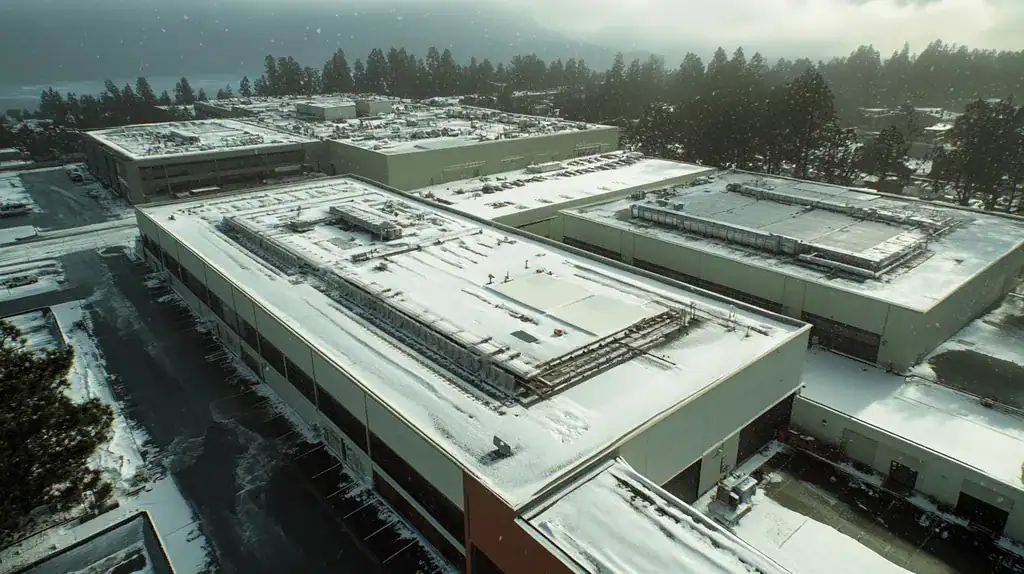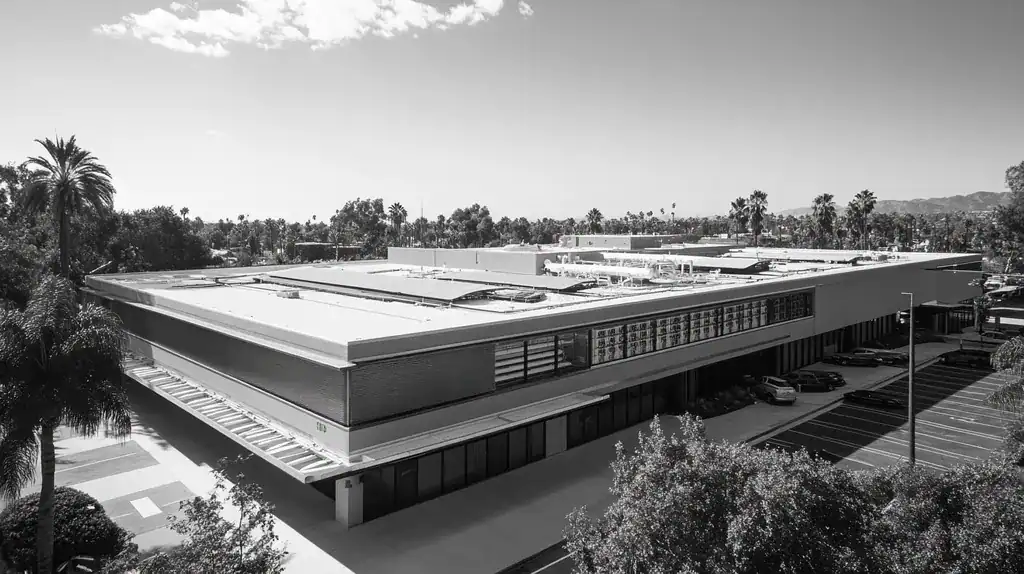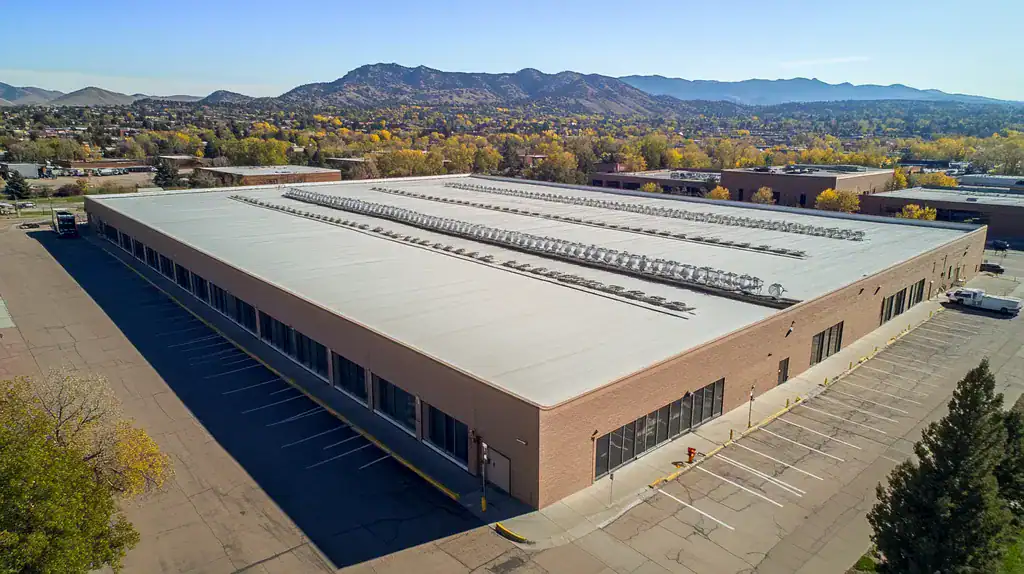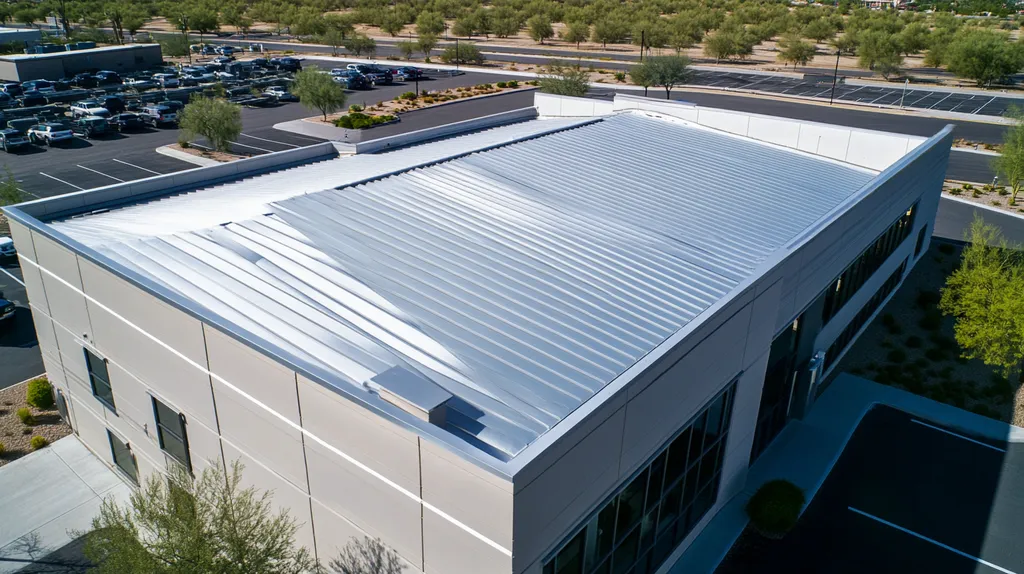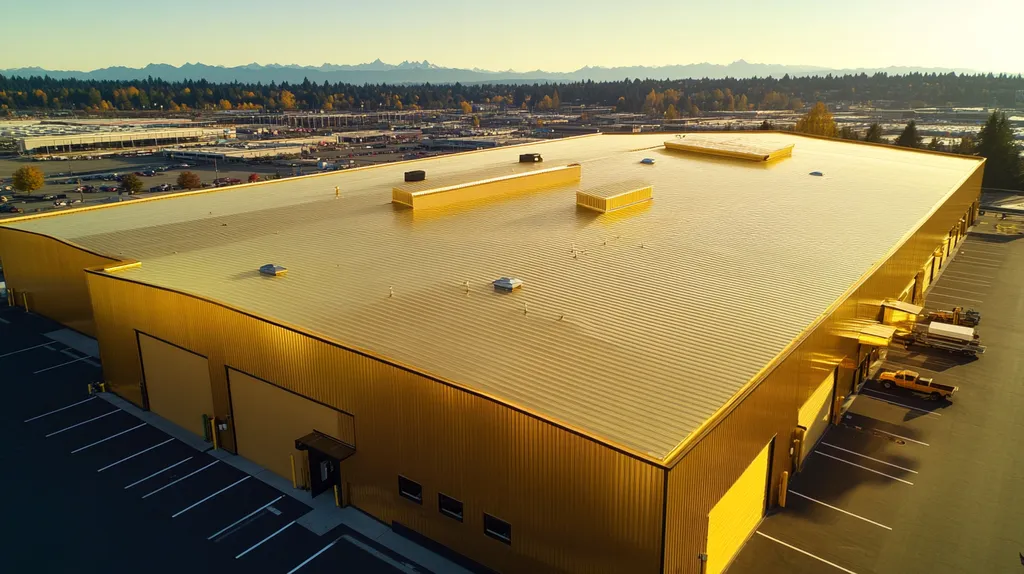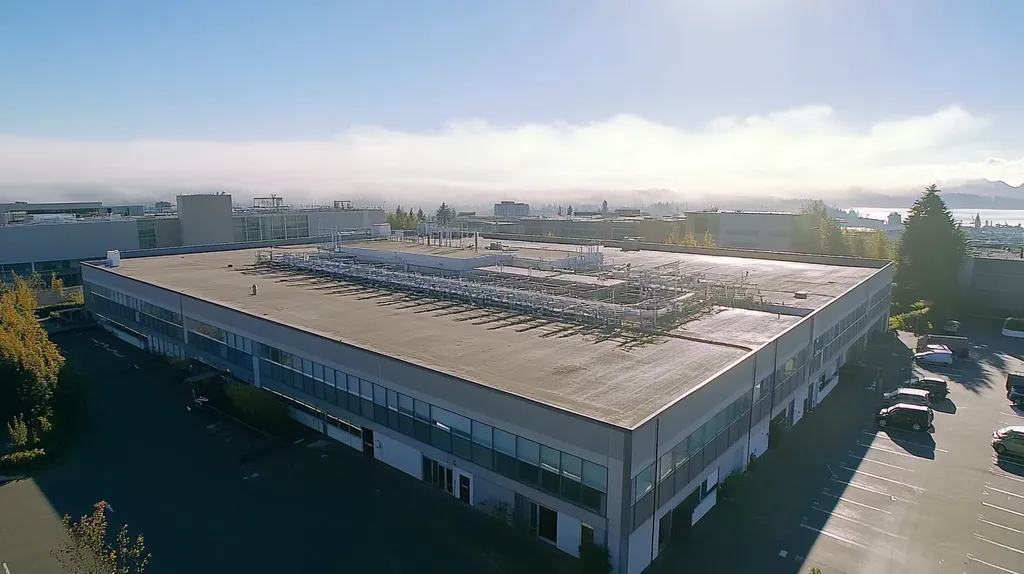Climate change is dramatically shortening the lifespan of commercial roofs, with 40% now requiring premature replacement due to weather-related damage, according to the National Roofing Contractors Association.
From extreme temperature fluctuations to increasingly severe storms, environmental factors are forcing property owners to fundamentally rethink their roofing strategies.
This comprehensive guide examines how climate impacts roof performance, financial planning, compliance requirements, and risk management—providing property professionals with actionable solutions to protect their investments and extend roof longevity.
SECTION 1: PERFORMANCE FACTORS
The environment significantly shapes the longevity of a commercial roof. In areas that experience extreme weather conditions, roofs endure accelerated wear and tear, which can lead to structural failures if not addressed timely. Alarmingly, approximately 40% of roof replacements are attributed to weather-related damage, according to the National Roofing Contractors Association. This section discusses vital performance factors—weather resistance, UV exposure, and thermal stress—that can profoundly influence roof durability.
Weather Resistance and Durability
A roof’s resilience against weather is crucial for its lifespan. Intense rains, snow, and strong winds can severely impact roofs that are not constructed from appropriate materials. For instance, flat roofs without effective drainage can accumulate water during heavy rainfall, leading to leaks and deterioration. Selecting weather-resistant materials like TPO or EPDM can significantly reduce these risks.
Moreover, the quality of installation is paramount in determining a roof’s performance. Faulty seals and inadequate flashing create weak points that extreme weather can exploit. Regular inspections and maintenance are essential to identify and rectify potential issues proactively, ultimately extending the roof’s service life.
A clear understanding of local weather patterns is vital for making well-informed decisions regarding roofing materials and installation techniques. Properties in areas with hostile climates may require sturdier materials and more frequent maintenance. Ignoring these environmental factors can result in premature roof failures.
Key Action Items
Heat and UV Impact Analysis
Intense heat and ultraviolet (UV) rays can cause significant damage to roofing materials, resulting in decreased performance over time. Synthetic materials, for example, may weaken or fade under constant exposure to high temperatures or UV radiation. This risk is amplified in regions with extended summer seasons or limited shade.
Thermal cycling—frequent changes in temperature—can also contribute to roofs expanding and contracting, which can lead to cracks and other forms of damage. Implementing reflective or cool roofing options can help diminish heat absorption and enhance the roof’s lifespan.
Moreover, selecting materials with built-in UV inhibitors provides an additional layer of protection, reducing the harmful effects of sun exposure and contributing to longer-lasting roofing performance.
Key Action Items
Thermal Stress and Material Degradation
Thermal stress significantly contributes to the degradation of roofing materials. Fluctuating temperatures cause roofs to expand and contract, weakening seams and joints, especially in climates with drastic temperature shifts from day to night.
Material selection is critical; while some materials may appear durable, they can be susceptible to cracking when subjected to thermal stress. Traditional asphalt shingles, for example, may become brittle, whereas more modern options like metal or modified bitumen can offer better performance in varying temperatures.
Additionally, extreme temperature changes can hasten the aging of roofing systems. Conducting regular evaluations can help discover early signs of thermal stress, allowing property managers to take preventive measures before more severe damage occurs.
Key Action Items
SECTION 2: FINANCIAL CONSIDERATIONS
The impact of climate change on commercial roofing is immediate and financially significant. With the surge in severe weather incidents, property owners face unexpected repair and replacement costs that could jeopardize their financial health. Understanding these implications is essential for protecting investments and ensuring roofs remain viable over the long term.
Cost of Climate-Related Repairs
The financial burden of climate-related roof repairs is on the rise. For instance, a single severe storm can inflict thousands of dollars in damage, leading to problems like dislodged shingles or leaks from water infiltration.
Long-term climate trends, such as rising heat and humidity levels, can cause roofing materials to degrade more quickly than expected, resulting in costly maintenance bills.
Regular assessments of roofs can help property managers stay ahead of wear and tear linked to climatic conditions. This proactive approach can significantly reduce unexpected repair costs and enhance the longevity of roofing systems.
Key Action Items
Insurance and Liability Assessment
The coverage that insurance policies provide often falls short when it comes to climate-related damage. Property owners must conduct regular reviews of their insurance to ensure they are adequately protected against potential liabilities stemming from climate events.
It is critical to grasp how insurance coverage deals with climate risks. Events like flooding may inflict extensive roof damage, but many policies impose limits or outright exclusions on such claims.
Conducting thorough risk assessments can help identify gaps in coverage, enabling property owners to modify their policies as needed to mitigate out-of-pocket expenses for climate-related incidents.
Key Action Items
Budgeting for Climate Resilience
Investments in climate-resistant roofing solutions can pay off by reducing future repair costs. Property owners should create budgets that allocate funds not only for immediate repairs but also for enhancements that bolster long-term durability.
For example, installing reflective roofing systems can lead to lower cooling expenses while extending roof longevity. This proactive spending becomes increasingly advantageous in regions prone to extreme heat.
Additionally, incorporating green roofing technologies, such as vegetative roofs, can provide multiple benefits including better insulation and improved stormwater management.
Key Action Items
SECTION 3: COMPLIANCE REQUIREMENTS
Compliance with regulatory standards and building codes is essential for maintaining the integrity of commercial roofs. Ignoring these requirements not only jeopardizes roof performance but also exposes property owners to legal penalties and unexpected repair costs. As climate change continues to escalate, a thorough understanding of compliance requirements is more crucial than ever. This section will explore regulatory standards, building codes focused on climate adaptation, and the importance of environmental regulations.
Regulatory Standards for Roofing
Various organizations, including the International Code Council (ICC) and local authorities, set regulatory standards for roofing materials and installation methods. These guidelines help ensure roofs can endure local weather challenges, including high winds and heavy snowfall. Adhering to these standards can extend a roof’s longevity and strength.
For instance, roofing systems in hurricane-prone areas are required to meet specific wind resistance ratings. Non-compliance can lead to substantial damage during severe weather, resulting in costly repairs and insurance claims.
Property owners should remain informed about any changes in these regulations to maintain compliance. Regular training for facility managers is necessary to ensure awareness of the latest requirements and best practices in roofing.
Key Action Items
Building Codes and Climate Adaptation
Building codes are established to ensure safety and durability in roofing systems. With climate patterns shifting, these codes are becoming more stringent regarding roof resilience. For example, many jurisdictions now require reflective roofing materials to reduce energy consumption and address urban heat effects.
Property owners should regularly review local building codes to keep their roofing systems compliant. While non-compliance may incur penalties, proactive adherence can significantly improve energy efficiency and lower operational costs.
Some jurisdictions even offer incentives for implementing sustainable roofing practices, like green roofs or solar energy systems. These initiatives meet building codes and demonstrate a commitment to environmental sustainability.
Key Action Items
Compliance with Environmental Regulations
As society increasingly prioritizes sustainability, environmental regulations have become paramount. Property owners must ensure their roofing systems comply with rules pertaining to waste disposal, material sourcing, and energy efficiency. Non-compliance can result in hefty fines and reputational harm.
For example, some regions mandate the use of low-VOC (volatile organic compounds) materials in roofing projects to improve air quality. Following these regulations not only ensures compliance but also enhances the indoor environment for occupants.
With growing demand for green building certifications, adherence to environmental regulations can significantly enhance property value and attractiveness to tenants. Understanding and complying with these regulations are vital for promoting a positive corporate image and extending roof lifespan.
Key Action Items
SECTION 4: RISK MANAGEMENT
Recognizing climate-related hazards is crucial for protecting the integrity of commercial roofs. Severe weather events, from heavy rainfall and intense heat to powerful winds, can significantly shorten a roof’s lifespan. Research indicates that rooftops in storm-prone areas can see a 30% increase in failure rates compared to those in more stable climates. Property owners and facility managers must act decisively to identify and mitigate these risks to safeguard their investments.
Identifying Climate-Related Hazards
Climate-related hazards pose the greatest threat to roofing systems. Heavy rainfall, snow load, and extreme heat can all accelerate the deterioration of roofing materials. Flat roofs, for instance, are especially prone to water pooling, leading to leaks and structural breakdown. Wind storms can further compromise roofs by dislodging key components, leaving underlying materials vulnerable to damage.
Additionally, shifts in regional weather patterns may introduce new hazards to previously stable areas. This evolving climate landscape necessitates ongoing evaluations to ensure roofs are prepared for unexpected weather extremes. Regular inspections are essential to pinpoint specific risks; property managers should actively watch for signs of wear, debris accumulation, and structural weaknesses—crucial steps in a solid risk management approach.
Key Action Items
Assessing Risk to Roof Integrity
Evaluating the risk to roof integrity is vital after identifying hazards. A thorough risk assessment examines current roof conditions and how climate factors may affect them. For example, aging materials are more susceptible to damage from strong winds or temperature fluctuations.
In addition to assessing the state of the roof, reviewing historical weather data is also crucial. This context allows property owners to anticipate future risks, facilitating better planning and resource allocation. Areas prone to hurricanes, for instance, may benefit from additional reinforcements to withstand high winds.
Conducting comprehensive risk assessments not only aids in choosing appropriate materials but also informs maintenance strategies and replacement schedules, reducing unforeseen costs and prolonging roof lifespans.
Key Action Items
Mitigating Weather-Induced Damage
Implementing proactive strategies can significantly minimize weather-induced damage. One effective tactic is investing in high-quality materials designed to withstand local climate conditions. For example, selecting roofing membranes with enhanced UV resistance can mitigate degradation in sun-intense areas.
Regular maintenance also plays a critical role in preventing minor issues from escalating. This includes routine clearing of gutters and drains to avoid water pooling, as well as prompt inspections following extreme weather events to identify any new damage. Enhanced drainage systems and wind-resistant structures can also help fortify roofs against severe storms.
By embracing a robust risk management framework, property managers can protect their roofs while supporting the long-term viability of the entire property. Adapting to local climate realities fosters resilience in commercial roofing systems and enhances financial stability.
Key Action Items
SECTION 5: OPERATIONAL PROCEDURES
As climate change escalates the severity of weather events, effective roofing management is paramount. Studies show that roofs sustain significant damage during extreme weather, resulting in expensive repairs and shorter lifespans. Property owners and facility managers need to employ proactive operational procedures to enhance the resilience of their roofs against unpredictable elements. This section highlights essential strategies, including regular inspections, climate-resilient designs, and emergency response planning to safeguard commercial roofs.
Regular Roof Inspections and Maintenance
Consistent roof inspections are vital for prolonging its lifespan, particularly in shifting climates. Property managers should plan biannual evaluations to discover potential problems before they worsen. These assessments should cover membrane integrity, drainage efficiency, and insulation condition, which can be compromised by extreme weather.
Beyond scheduled evaluations, maintaining a routine maintenance plan is essential. This includes prompt repairs of identified issues, gutter cleaning, and debris removal to prevent moisture buildup. Effective drainage is crucial; stagnant water can result in leaks and structural damage.
Keeping detailed records of inspections and maintenance activities helps track the roof’s condition over time. This documentation can reveal patterns that may signal future vulnerabilities or necessary upgrades driven by climatic changes.
Key Action Items
Implementing Climate-Resilient Designs
Adopting climate-resilient roofing designs profoundly enhances both lifespan and performance. Property owners should opt for materials and systems tailored to withstand local environmental conditions. For example, reflective membranes can help reduce heat absorption in hot regions, thereby lowering energy costs and protecting the roof.
Utilizing advanced weather-resistant materials increases resilience. Synthetic underlayments and reinforced membranes provide enhanced protection against wind uplift and moisture intrusion, forming extra barriers against severe storms.
Furthermore, implementing design features such as proper slope and drainage configurations can minimize water pooling, critical in areas with heavy rainfall or snowfall, where excess moisture can hasten deterioration.
Key Action Items
Emergency Response Planning for Weather Events
An effective emergency response plan is crucial for minimizing damage during severe weather events. Property managers must create a well-defined action plan that guides immediate actions, protecting both occupants and the structure’s integrity.
This plan should establish clear lines of communication, defining roles and responsibilities for staff during emergencies. This clarity enables rapid decision-making and coordination, which is vital in critical situations.
Property owners should also connect with local emergency services and contractors for streamlined repair processes. Having pre-identified service partners can speed up repairs, reducing downtime and financial losses. Regular revisions of the response plan ensure it remains effective amidst changing climate conditions.
Key Action Items
SECTION 5: OPERATIONAL PROCEDURES
With the intensification of climate change, the need for effective roofing management has reached critical levels. Studies show that roofs can suffer severe damage during extreme weather events, resulting in costly repairs and reduced lifespans. Property owners and facility managers must implement proactive operational procedures to bolster the durability of their roofs against unpredictable weather. This section outlines essential strategies like regular inspections, climate-resilient designs, and emergency response planning to protect commercial roofs.
Regular Roof Inspections and Maintenance
Regular inspections are essential for extending the lifespan of roofs, especially in changing climates. Property managers should schedule biannual inspections to detect potential issues before they escalate into more significant problems. This practice encompasses checking for membrane tears, drainage inefficiencies, and any damage to insulation, all of which can worsen under extreme weather conditions.
Alongside scheduled inspections, property management teams must maintain a routine maintenance plan. This plan includes promptly addressing identified problems, cleaning gutters, and clearing away debris that can trap moisture. Effective drainage is crucial; without proper drainage systems, standing water can lead to leaks and other structural damage.
Keeping detailed records of inspections and maintenance activities provides valuable insights into the roof’s condition over time. This documentation can help identify patterns that inform future vulnerabilities or necessary upgrades in response to evolving climate conditions.
Key Action Items
Implementing Climate-Resilient Designs
Climate-resilient roofing designs are crucial for enhancing longevity and performance. Property owners should consider using materials and systems specifically engineered to endure local environmental challenges. For example, reflective membranes help reduce heat absorption in warmer climates, ultimately lowering energy costs and protecting the roof.
Incorporating advanced weather-resistant materials boosts resilience. Utilizing synthetic underlayments and reinforced membranes offers improved defense against wind uplift and moisture infiltration, creating essential barriers against severe storms.
Additionally, strategic design features like properly configured slopes and drainage systems can minimize water pooling. This is especially important in regions that experience heavy rainfall or snowfall, where excess moisture can lead to rapid deterioration.
Investments in infrastructure that prioritizes climate resilience underscore a commitment to sustainability and operational efficiency. This proactive approach can greatly enhance the lifespan of a commercial roof while reducing long-term repair costs.
Key Action Items
Emergency Response Planning for Weather Events
Having a robust emergency response plan is essential for minimizing damage during severe weather events. Property managers must create a comprehensive action plan that directs immediate actions, prioritizing the safety of occupants and the integrity of the building.
This plan should clearly outline communication strategies, defining staff roles and responsibilities during emergencies. Such clarity enables quick decision-making and effective coordination, which is crucial when rapid action is required.
Additionally, property owners should establish connections with local emergency services and reliable contractors. Having pre-identified service providers can facilitate faster repairs, reducing potential downtime and financial loss. Regularly updating the plan ensures it remains effective as climate conditions continue to evolve.
Lastly, conducting emergency drills can prepare staff for real-life scenarios. By practicing the response procedures, the team will be better equipped to handle unexpected weather events, reinforcing overall building resilience.
Key Action Items
The Bottom Line
With 40% of commercial roofs now requiring premature replacement due to climate-related damage, property owners can no longer afford to ignore environmental impacts on roofing systems.
The financial stakes are substantial – weather-related roof failures cost U.S. businesses over $2.8 billion annually in repairs and lost productivity.
Success requires a comprehensive approach incorporating climate-specific material selection, enhanced maintenance protocols, and robust emergency response planning.
Property owners who implement the strategies outlined in this guide position themselves to extend roof lifespans by 25-40% while reducing annual maintenance costs by up to 30%.
The time for proactive climate adaptation in commercial roofing is now – before the next severe weather event strikes.
FREQUENTLY ASKED QUESTIONS
Q. How do weather conditions affect the lifespan of a commercial roof?
A. Weather conditions significantly influence roof durability. Extreme temperatures, heavy rains, and strong winds can accelerate wear. Understanding local weather patterns is key to selecting appropriate materials and maintenance strategies.
Q. What financial impacts arise from climate-related damage to industrial roofs?
A. Climate-related damage can lead to high repair costs, impacting budgets significantly. Unexpected storm damage may require immediate funds for repairs, while ongoing wear and tear can result in costly maintenance over time.
Q. What are the compliance requirements for commercial roofs?
A. Compliance with local building codes and regulatory standards is crucial. These guidelines ensure roofing materials can withstand regional climate challenges, and failing to adhere may incur penalties or lead to unsafe conditions.
Q. How can I identify climate-related hazards for my commercial roof?
A. Conduct regular inspections to identify potential hazards. Look for signs of wear, water pooling, and assess weather patterns that may introduce new risks to your roofing system.
Q. What operational procedures are important for roof maintenance?
A. Regular inspections and robust maintenance plans are crucial. Schedule evaluations, promptly address issues, and keep records of maintenance activities to track the roof’s health consistently.
Q. What types of roofing materials are best for climate resilience?
A. Choose materials designed for local climate challenges, such as reflective membranes to reduce heat absorption. Reinforced membranes can also enhance protection against wind and moisture, improving longevity.
Q. How can I enhance the sustainability of my commercial roof?
A. Enhance sustainability by incorporating green roofing technologies like vegetative roofs or solar panels. These options improve insulation, reduce energy costs, and contribute positively to the environment.

